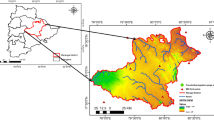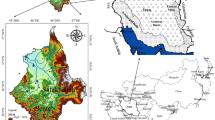Abstract
This research evaluated climate change impacts on water resources using soil and water assessment tool (SWAT) models under representative concentration pathway scenarios (RCP 2.6, RCP 6, RCP 8.5). First, drought intensity was calculated using the standardized precipitation index (SPI) for the period 1987–2016. Then, the coefficients of precipitation as well as minimum and maximum temperature changes were simulated as SWAT model inputs. The results revealed that temperature will rise in future periods and the precipitation rate will be changed consequently. Then, changes in runoff during periods of 2011–2040, 2041–2070, and 2071–2100 were simulated by introducing downscaled results to SWAT model. The model was calibrated and validated by SWAT calibration and uncertainty procedures (SWAT-CUP). Nash-Sutcliffe (NS) coefficients (0.57 and 0.54) and R2 determination coefficients (0.65 and 0.63) were obtained for calibration and validation periods, respectively. The results showed that runoff will rise in fall and spring while it will drop in winter and summer throughout future periods under all three scenarios. Such seasonal shifts in runoff levels result from climate change consequences in the forms of temperature rise, snowmelt, altered precipitation pattern, etc. Future-period evapotranspiration will rise under all three scenarios with a maximum increase in the period 2070–2100 under RCP 8.5 scenario. Additionally, rainfed crop yields will decline without considerable changes in irrigated and horticultural crop yields.









Similar content being viewed by others
References
Al Qatarneh, G. N., Al Smadi, B., Al-zboon, K., & Shatanawi, K. M. (2018). Impact of climate change on water resources in Jordan: a case study of Azraq basin. Applied Water Science, 50, 1–14.
Alamdarlo, H. N., Ahmadian, M., & Khalilian, S. (2014). Application of stochastic dynamic programming in water allocation, case study: Latian dam. World Applied Sciences Journal, 30, 838–843.
Alipour, A., Hashemi, M., Pazhooh, F., & Naserzadeh, M. H. (2017). Recognize and compare Iran’s deserts from the aspect of geomorphology and climatology (case study: Iran’s east and central areas desert). Iranian Journal of Eco Hydrology, 7, 21–34.
Azamzadeh Shouraki, M., Khalilian, S., & Mortazavi, S. A. (2013). Effects of declining energy subsidies on value added in agricultural sector. Journal of Agricultural Science and Technology, 15, 423–433.
Bajracharya, S. R., Bajrachaya, A. R., Shresta, A. B., & Maharjan, S. B. (2018). Climate change impacts assessment on the hydrological regime of the Kaligandaki basin, Nepal. Science of the Total Environment, 625, 837–848.
Besalatpour, A. A., Ayoubi, S., Hajabbasi, M. A., & Jalalian, A. (2015). Calibration and validation of SWAT model using PSO algorithm for the simulation of runoff and sediment in a mountainous watershed with limited climate data. Journal of Soil Management and Sustainable, 4, 295–312.
Climate change, I. P. C. C. (2001). In J. T. Houghton, L. G. M. Filho, B. A. Callander, N. Harris, A. Attenberg, & K. Maskell (Eds.), The science of climate change. Contribution of working group I to the second assessment report of the intergovernmental panel on climate change. Cambridge: Cambridge University Press.
Daba, M. (2018). Sensitivity of SWAT simulated runoff to temperature and rainfall in the Upper Awash Sab-Basin, Ethiopia. Hydrology Current Research, 9, 1–7.
Delavar, M., Farmanbar, Z., & Imani Amirabadi, S. (2018). The effects of climate change on water resources and agricultural systems in the context of regional risk assessment (case study: Lake Zaribar Basin). Iran Water Resources Research, 13, 75–88.
Devkota, L. P., & Gyawali, D. R. (2015). Impacts of climate change on hydrological regime and water resources management of the Koshi river basin, Nepal. Journal of Hydrology, 4, 502–515.
Eini, M. R. (2019). Discussion of ‘intra-and interannual streamflow variations of Wardha watershed under changing climate’ (2018) by Naga Sowjanya P., Venketa Reddy K. and Shashi M. ISH Journal of Hydraulic Engineering, 1–2.
Ghermezcheshmeh, B., Hajimohammadi, M., & Azizian, A. (2018). Evaluation of the impact of climate change on runoff Kan watershed. Watershed Engineering and Management, 10, 144–156.
Harmsen, E., Miller, N. L., Schlegel, N. J., & Gonzalez, J. E. (2009). Seasonal climate change impacts on evapotranspiration, precipitation deficit and crop yield in Puerto Rico. Agricultural Water Management, 96, 1085–1095.
IPCC. (2007). Summary for Policy makers, in: Climate Change, Solomon, S.D., Qin, M., Manning, Z., Chen, M., Marquis, K.B., Averyt, M. and Tignor, H.L. Climate Change 2007. The physical science basis. Contribution of Working Group I to the Fourth Assessment Report of the Intergovernmental Panel on Climate Change, Cambridge University Press.
Kishiwa, P., Nobert, J., Kongo, V., & Ndomba, P. (2018). Assessment of impacts of climate change on surface water availability using coupled SWAT and WEAP models: case of upper Pangani river basin, Tanzania. International Association of Hydrological Sciences, 378, 23–27.
Leta, O. T., El-Kadi, A., & Dulai, H. (2018). Impact of climate change on daily streamflow and its extreme values in Pacific Island watersheds. Sustainability, 2057, 1–22.
Loukas, A., Vasiliades, L., & Tzabiras, J. (2008). Climate change effects on drought severity. Advanced in Geosciences, 17, 23–29.
Montaseri, M., & Amirataee, B. (2016). Comprehensive stochastic assessment of meteorological drought indices. International Journal of Climate, 31, 162–173.
Sharannya, T. M., Mudbhatkal, A., & Mahesha, A. (2018). Assessing climate change impacts on river hydrology- a case study in the Western Ghats of India. Indian Academy of Sciences, 78, 1–11.
Shrestha, B., Cochrane, T. A., Caruso, B. S., Arias, M. E., & Piman, T. (2016). Uncertainty in flow and sediment projections due to future climate scenarios for the 3S Rivers in the Mekong Basin. Journal of Hydrology, 540, 1088–1104.
Wilby, R. L., & Harris, I. (2006). A frame work for assessing uncertainties in climate change impacts: low flow scenarios for the River Thames, UK. Water Resources Research, 42, 1–10.
Xu, C. H. (1999). From GCMs to river flow: a review of downscaling methods and hydrologic modelling approaches. Physical Geography: Earth and Environment, 23, 229–249.
Yang, M., Xiao, W., Zhao, Y., Li, X., Huang, Y., Lu, F., Hou, B., & Li, B. (2018). Assessment of potential climate change effects on the rice yield and water footprint in the Nanliujiang catchment, China. Sustainability, 242, 1–19.
Yin, J., Yuan, Z., Yan, D., Yang, Z., & Wang, Y. (2018). Addressing climate change impacts on streamflow in the Jinsha River basin based on CMIP5 climate models. Water, 910, 1–19.
Zarezadeh Mehrizi, M. (2011). Water allocation in Ghezel-Ozan Basin under climate change using bankrupting in conflict resolution. Dissertation, Tarbiat Modares University.
Zhou, Y., Lai, C., Wang, Z., Chen, X., & Zeng, Z. (2018). Quantitative evaluation of the impact of climate change and human activity on runoff change in the Dongjiang River basin, China. Water, 571, 1–17.
Author information
Authors and Affiliations
Corresponding author
Additional information
Publisher’s note
Springer Nature remains neutral with regard to jurisdictional claims in published maps and institutional affiliations.
Rights and permissions
About this article
Cite this article
Shahvari, N., Khalilian, S., Mosavi, S.H. et al. Assessing climate change impacts on water resources and crop yield: a case study of Varamin plain basin, Iran. Environ Monit Assess 191, 134 (2019). https://doi.org/10.1007/s10661-019-7266-x
Received:
Accepted:
Published:
DOI: https://doi.org/10.1007/s10661-019-7266-x




